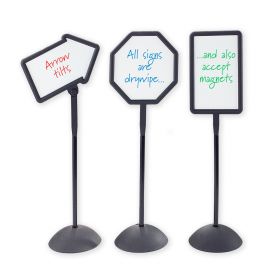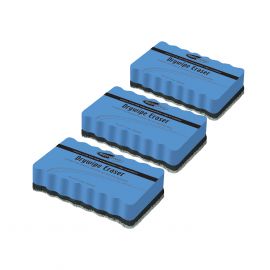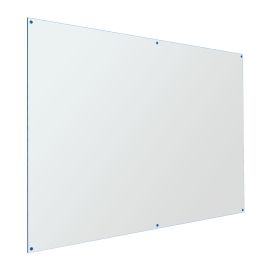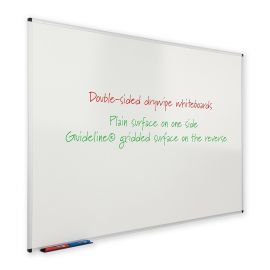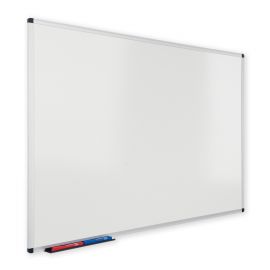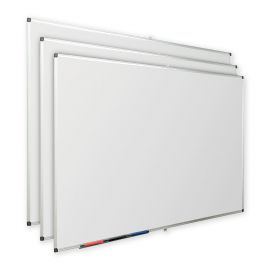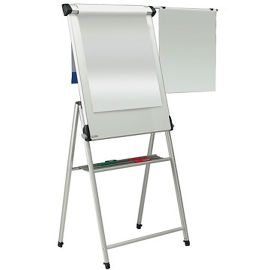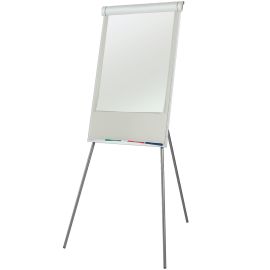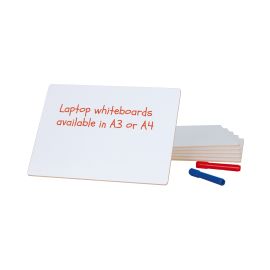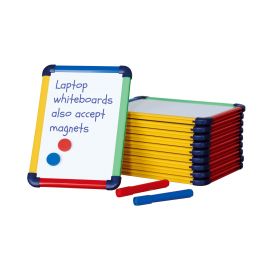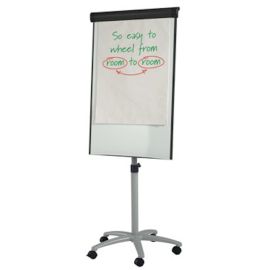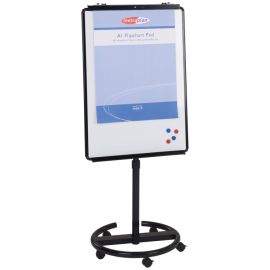A Multitude of Uses for the Humble Whiteboard
- 28 Jun 2021

A Multitude of Uses for the Humble Whiteboard
Imagine you’re in a conference, classroom, or meeting room with an attentive audience. They are fully engaged and you want to get your message across before the session ends. What’s the best tool you’ll turn to?
The trusty humble whiteboard is a quick, reliable, and handy way to get your message across and enable fast, easy note-taking. With whiteboards, you can inform, brainstorm, and quickly transform your ideas into easy-to-understand charts, diagrams, and words.
Whiteboards have certainly come a long way over the years, now with more useful bells & whistles to suit a wide range of needs. For example, models with magnetic backing or a joined cork section make it easy to attach pens, papers, and so on.
On the other hand, whiteboard planners and calendars are perfect for avid planners and office organisers. Whether you’re a student, professional, or teacher, you can appreciate how they make the exchange of information and ideas interactive, fun, and meticulous.
While the humble whiteboard is the workhorse of the teaching and boardroom world, they’ve got a boatload of other uses outside of these settings. They’re also splendid for play and fun.
In this post, we’re going to walk you through the vast array of uses of the mighty whiteboard, including the many different types of people and industries that use them. Look ahead for the creative ways you can use whiteboards to help you and your establishment.

Education Sector - Uses of the whiteboard in teaching
Today’s classroom is jam-packed with tools and equipment meant to facilitate teaching, keep learners engaged, and make sure they’re adequately learning from morning until the last ring of the bell. And the humble whiteboard is right at the forefront of it all.
What’s more, whiteboards can be used inside and outside the classroom at all levels of the school system, from nursery and primary school all the way up to secondary school and university. Education is the cornerstone of our society, and whiteboards are there to ensure learners can absorb as much information delivered by teachers and tutors as possible.
Whiteboards have many pedagogical uses in the classroom, which include the following:
- Practising/solving mathematics problems -
Let’s be honest; most pupils don’t like mathematics, and part of the problem is how the subject is taught. This is where whiteboards can come in handy. By writing out mathematics problems on the board, learners have the flexibility to rub and retract their steps, helping them work through these math problems at their own pace. The idea of starting on a “clean slate” can help change children’s attitude towards this valuable subject. - Vocabulary building -
Educators often encourage pupils and students to read often to build their vocabulary. But how can they practice it? With a whiteboard, practising vocabulary words is easier than ever. It’s a simple yet effective way to do so, plus it makes sure the whole classroom is engaged. - Q&A made easy -
The teacher can simply write or speak out the questions, and give the pupils their turn to write answers on the whiteboard. Space isn’t an issue because the board can be erased quickly at any point in the Q&A session. - Brainstorming -
When students are collaborating on an assignment or project, it pays for them to draw or write down their ideas. Being able to outline and visualize their ideas can help speed up the process and solve any problems that may arise. This can be particularly useful to visual students - they can easily brainstorm ideas by writing, erasing, and rewriting them as needed without the need for a big space. - Interactive play and learning -
When it comes to nurturing young minds, there’s nothing that beats fun combined with interactive learning. Students and pupils can use the whiteboard to set up and play their favourite educational games like Pictionary, Tic Tac Toe, Dictation race, and so on. We’ve seen students use whiteboards to play Pictionary with a lot of excitement. - Teaching spelling -
Whiteboards can work wonders for pupils who are still learning their spelling. They are more likely to absorb and retain spelling lessons when they hand-write them on the whiteboard. The teacher can make the learning process more interactive by splitting them into groups. - Homeschooling -
The benefits of using whiteboards for homeschooling are plentiful and diverse. The board provides unlimited space for engaged, visual, and interactive learning. You can also use the whiteboard to post your daily schedule, create calendars, and for visual assessment, helping take your homeschooling to a whole new level.
Read more: How to Set Up a Fun Home Classroom

Home Office
Whether you’re a freelancer, student, or remote worker, having a fully equipped home office can make a massive difference. The whiteboard can play numerous roles in your home office, helping bring good balance to your work and life:
- Message board -
You probably live with multiple people in your home and not everyone is savvy with technology. You can’t simply send a Whatsapp or Facebook message to everyone. Whiteboards inside or outside your office can serve as a great message board. - Task manager -
Whiteboards can double up as the space for your daily, weekly, or monthly task lists. There will be no delays, no hassle, and most importantly, no forgetting to complete your tasks. - Declutter your desk/life -
Most whiteboards are fitted with magnetic backing or holder sections. This makes it easy for you to use it as your “pending area”. Simply attach unfiled faxes, letters, receipts, invoices, paperwork, and other documents that need your attention over the course of the day or week. This can work amazingly in tandem with your daily task list.
You can also use whiteboards in your home office as your inspiration area, contact number list, calendar, planner, and for a variety of other tasks like brainstorming, presentation, and more.
Read more: Tips for Working from Home
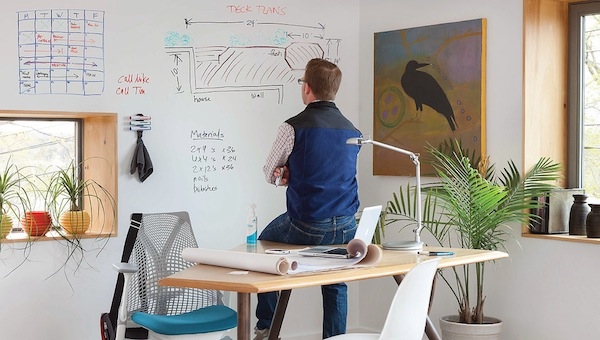
Corporate Boardrooms
Whiteboards have for many decades been the mainstay feature of the modern corporate or business boardroom. You can turn one or many walls of the boardroom into an interactive writing surface for meetings, conferences, brainstorming sessions, and other corporate events.
The benefits of installing whiteboards in your corporate or office boardroom are too many and important to ignore:
- They enhance corporate boardroom meeting culture - Forget about meetings where one person does all the heavy lifting. With whiteboards, everyone can contribute to the conversation.
- Take your conferences to the next level - You can use a whiteboard to make the conference interactive and boost engagement.
- Get your meetings off the ground quickly - Whiteboards require very little set-up, plus you can create charts and drawings long before the meeting starts.
- Generate more engaging presentations - You can use the whiteboard for brainstorming, training, illustrating, and much more, which creates more engaging presentations.
- Include remote attendees - This rings true for those who own or plan to install interactive whiteboards.

IT Industry
IT departments and organisations always look for creative ways to manage their time better and deliver high-quality services and products more efficiently. For instance, if you’re tasked with creating a piece of software, you’ll have to go through manifold rounds of meetings.
This is why whiteboards have become indispensable in the IT industry. They help convert cubicle and office walls into working/writing surfaces, so you can get the most out of your IT space. They can be used for illustration, presentation, brainstorming, and pitching ideas to clients.
Whiteboards can truly transform the way IT departments and companies work. And they come in especially useful in a number of applications that include:
- Using the whiteboard for both writing and as a projector screen
- Setting up meetings and noting down task lists
- Keeping track of deadlines, projects, and other aspects of deliverables
- Using colour codes to generate useful and clear display areas
- Communicating ideas and temporary messages
- Handy tool for IT conferences and meetings
Read more: How Could Your IT Department Benefit from a Whiteboard

Hospitals
At their core, whiteboards are used in hospital and health centres to facilitate communication between providers and patients, as well as other employees. They help medical providers and work staff communicate better with each other.
Aside from doctor-patient communication, whiteboards have a plethora of other applications in the hospital environment. For instance, they’re often used in the following areas:
- Nurse stations -
It’s no secret that nurses use and interact with whiteboards more often than anyone in a hospital. They use them to track their schedules, patient locations, medication routine, etc. - Labs -
In a laboratory setting, whiteboards are used to track schedules, evaluations, testing status, and so on. - Hospital admission -
While most hospitals use software applications to track bed status and admission, whiteboards can also be used in place or in conjunction with computerized systems. - Tracking and scheduling -
Whiteboards are typically used behind the scenes in health facilities as tracking and scheduling tools for maternity, emergency rooms, surgical rooms, and other areas.
They are also used in the administration and office areas of the hospital for a broad range of usages.
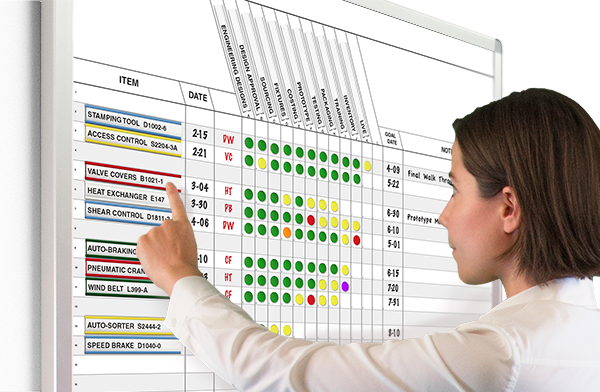
Conclusion
Whiteboard use isn’t restricted to classrooms, corporate boardrooms, IT departments, and hospitals. Other industries where they are commonly used include media & entertainment, hospitality/tourism, and the government sector. More often than not, they’re used for planning, scheduling, tracking, presentation, and brainstorming.
If you enjoyed this article, you may also like…
Whiteboards: The Ultimate Guide
Shop here:

